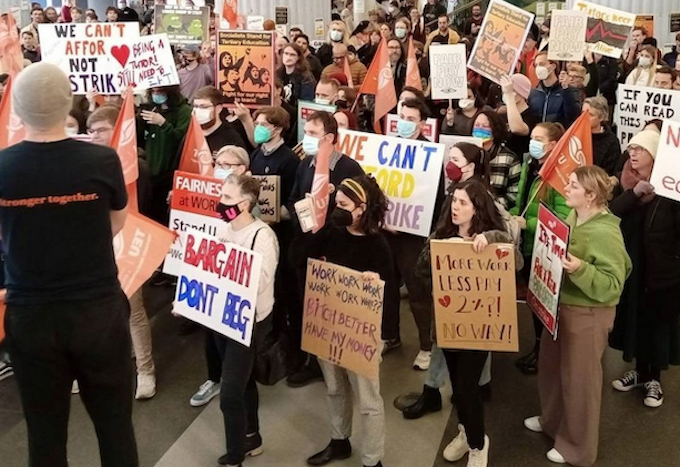
ANALYSIS: By Nicola Gaston, University of Auckland
The crisis in Aotearoa New Zealand’s university and wider research sector did not happen overnight. While funding shortfalls and sweeping redundancies are now making headlines, the underlying problems have been evident for years.
As I wrote after last year’s budget, financial support for research across our universities and crown research institutes “is steadily eroding and has been doing so for some time”, given the impacts of inflation.
The year before was no better. “The 2021 budget is not the investment we needed to see,” I wrote then. “Anything other than an increase in line with inflation is rather a slap in the face.”
- READ MORE: ‘Tragic’ blow for staff as Victoria University proposes cuts to jobs and entire subjects
- University funding debates should be broadened to reflect their democratic purpose
- The arts helped us through the pandemic – NZ’s budget should radically rethink how and why they’re funded
- Are New Zealand’s universities doing enough to define the limits of academic freedom?
And of 2020’s covid-dominated budget, I could only say: “Under normal conditions, I might describe this as a disappointing budget for science [. . . ] missing not merely in action, but in aspiration.”
It was a similar story in 2019, with a 1.8 percent increase to tertiary tuition subsidies only slightly alleviating inflation pressure; and in 2018, when the government restated its intention to lift research funding to 2 percent of gross domestic product (GDP) over 10 years.
That 2 pecent of GDP target has been around for a long time now, with little significant movement and a current spend of 1.47 percent. The lack of new funding for science and research in recent successive budgets might once have been explained by sector reform being a work in progress.
But time is running out.
With redundancies wreaking havoc across the university sector in particular, getting new funding into the system should have been a priority in this year’s budget. The opportunity cost of not doing this is simply too great.
Challenge and capacity
The university sector is now undeniably in crisis, with the scale of the cuts — most seriously at Otago and Victoria University of Wellington, but also at Waikato and Massey — becoming clearer in the past few weeks.
The Prime Minister and Minister of Education refuse to interfere in what they see as operational matters, saying universities need to adapt to changing realities.
And there is little doubt universities face real challenges, from the changing nature of work, to increased expectations of digital learning, and the implications of artificial intelligence tools.
‘Tragic’ blow for staff as Victoria University makes cuts to jobs and entire subjects https://t.co/242Of0DceT
— RNZ News (@rnz_news) June 21, 2023
But cutting staff undermines the sector’s capacity to deal with those challenges in the first place — because capacity lies at the heart of this issue. As former prime minister Helen Clark said last week:
It has taken decades to build the current capacities of our universities. That should not be destroyed by short-term budgetary considerations. The money required to maintain viable and comprehensive universities is small in the overall scheme of things.
The missing money may indeed be small. But a lack of inflation adjustment over multiple years has created real problems — especially given universities did not qualify for any financial support during covid-19, and have cut or not replaced staff over the past three years already.
We are falling further behind Australia in terms of everything, especially the recruitment of high-quality academic staff and research funding, argues Ananish Chaudhuri https://t.co/w7GZSuaUMc
— Newsroom (@NewsroomNZ) June 14, 2023
A system at odds with itself
This year, the key budget hole is traceable to a dip in student numbers, likely related to sub-optimal student experiences during the pandemic, and perhaps the relatively strong job market.
It is easy to sympathise with this, and to hope those students return to tertiary education in future. The question is, what will our universities look like if and when they do?
That research funding target of 2 percent of GDP — reiterated again in this year’s budget — has been with us since 2017.
Patience was encouraged on the basis that, while government funding was below target, business expenditure on research and development (R&D) was even worse. We needed to wait for R&D tax credits to move that dial before government funding would increase.
But the reverse is now true. As last year’s white paper from science sector reform programme Te Ara Paerangi-Future Pathways made clear, it was no longer business R&D capacity that was holding us back — it was capacity on the public side:
The current [research, science and innovation] system is poorly placed to utilise increased funding to prepare us for [the] future.
That the loss of capacity threatened by current university cuts seems not to have raised concerns in government about the viability of its own research strategy suggests something is profoundly wrong.
OPINION: The removal of Asian studies programmes will leave us more isolated, more ignorant and less competitive. https://t.co/0vj7u3VRaX
— Stuff (@NZStuff) June 15, 2023
Simple funding solutions
The immediate solution shouldn’t be that hard. As has been pointed out elsewhere, money to cover projected higher student enrolments was originally budgeted for by the government.
The decision not to allocate that money due to lower than expected enrolments is really a question of funding priorities and structures.
The research activities of universities are supported first through baseline funding to ensure there is available capacity; and secondly through contestable grants that allow governments to invest in research areas on strategic grounds (such as health or economic development).
A shift in the balance between baseline and per-student funding is not a dramatic structural change. An alternative might be to set a floor on how much per-student funding can be cut from one year to the next — just like the government sets a cap on raising student fees, for example.
In our dysfunctional system, it often appears the university’s chief role is as real estate developer. https://t.co/ofBs1JRjMA
— Stuff.co.nz Politics (@NZStuffPolitics) June 14, 2023
A coordinated national strategy
In the longer term, it would also be good to see stronger coordination and collaboration between universities at both governance and academic levels.
Perhaps a “supercouncil” composed of representatives of each university council could provide the forum for this. It would help ensure individual university strategies were complementary, making the most of their distinctiveness and responsibilities to local communities.
And to address those concerns about adaptation to modern realities, a ministry of education initiative to develop strategic plans for disciplines and programmes (with academic input) would be welcome.
The relationship between university research and teaching, mandated in the Education Act, should mean that changing research realities have implications for how and what we teach.
It is a matter of academic freedom that universities and academics make these decisions themselves. But having national strategic thinking available to support those decisions could only be a good thing.
At the very least, it would be rather more strategic than making these decisions based on the order in which staff apply for redundancy.![]()
Dr Nicola Gaston, co-director of the MacDiarmid Institute for Advanced Materials and Nanotechnology, University of Auckland. This article is republished from The Conversation under a Creative Commons licence. Read the original article.













































Primary School and High School teachers go on strike to fight for better wages and conditions.
Why do university lecturers and university staff not do the same?
Comments are closed.